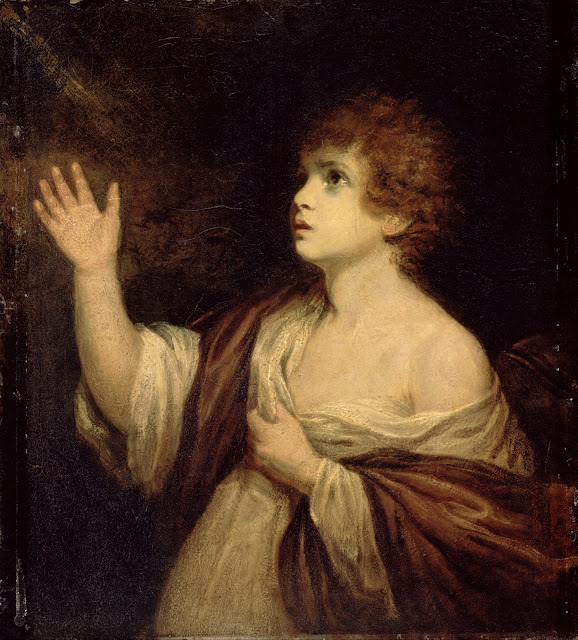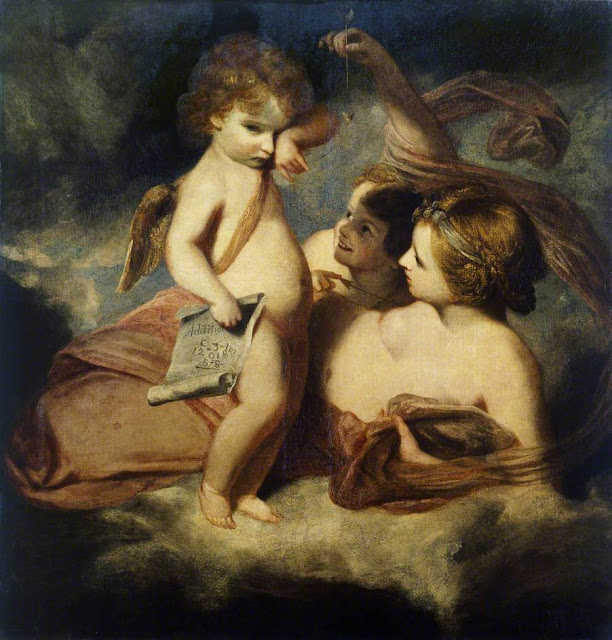 |
| c1775 Self-Portrait oil on canvas 73.7 x 61 cm Tate Gallery, London |
Sir Joshua Reynolds was the leading English portraitist of the 18th century. Through study of ancient and Italian Renaissance art, and of the work of Rembrandt, Rubens, and Van Dyck, he brought great variety and dignity to British portraiture. He was born at Plympton in Devon, the son of a headmaster and fellow of Balliol College, Oxford: a more educated background than that of most painters.
He was apprenticed in 1740 to the fashionable London portraitist Thomas Hudson, who also trained Joseph Wright of Derby. He spent 1749-52 abroad, mainly in Italy, and set up practice in London shortly after his return. He soon established himself as the leading portrait painter, though he was never popular with George III. He was a key figure in the intellectual life of London, and a friend of Dr Johnson.
When the Royal Academy was founded in 1768, Reynolds was elected its first President. Although believing that history painting was the noblest work of the painter, he had little opportunity to practise it, and his greatest works are his portraits. His paintings are not perfectly preserved due to faulty technique. The carmine reds have faded, leaving flesh-tones paler than intended, and the bitumen used in the blacks has tended to crack. The National Gallery, London
For more biographical details see part 1, and for earlier works see parts 1 - 4 also.
This is part 5 of an 8-part series on the works of Sir Joshua Reynolds:
%20oil%20on%20canvas%20(size%20not%20given)%20Harewood%20House,%20Harewood,%20Yorkshire,%20UK.jpg) |
| 1775 Miss Fleming as Aurora later Jane Stanhope, Countess of Harrington oil on canvas (size not given) Harewood House, Harewood, Yorkshire, UK |
 |
| c1778-79 Jane Fleming later Countess of Harrington oil on canvas 239.4 x 147.5 cm The Huntington Library, Art Museum and Botanical Gardens, San Marino, CA |
 |
| 1775 Lady Louisa Conolly oil on canvas 136.5 x 99.7 cm Harvard Art Museums, MA |
%20oil%20on%20canvas%2076%20x%2063%20cm%20The%20Huntington%20Library,%20Art%20Museum,%20and%20Botanical%20Gardens%20San%20Marino,%20CA.jpg) |
| 1775 Samuel Johnson ("Blinking Sam") oil on canvas 76 x 63 cm The Huntington Library, Art Museum, and Botanical Gardens. San Marino, CA |
 |
| 1775-76 Miss Jane Bowles oil on canvas 91 x 70.9 cm The Wallace Collection, London |
%20Cavendish,%20Duchess%20of%20Devonshire%20oil%20on%20canvas%20239.4%20x%20147.5%20cm%20The%20Huntington%20Library,%20Art%20Museum%20and%20Botanical%20Gardens,%20San%20Marino,%20CA.jpg) |
| c1775-76 Georgiana (Spencer) Cavendish, Duchess of Devonshire oil on canvas 239.4 x 147.5 cm The Huntington Library, Art Museum and Botanical Gardens, San Marino, CA |
%20oil%20on%20canvas%2091.5%20x%2071.2%20cm%20English%20Heritage,%20Kenwood%20House,%20London.jpg) |
| c1775-82 Girl Leaning on a Pedestal (The Laughing Girl) oil on canvas 91.5 x 71.2 cm English Heritage, Kenwood House, London |
,%201st%20Earl%20of%20Ely,%20and%20His%20Wife%20Frances%20Monroe%20(d.1821),%20Countess%20of%20Ely%20oil%20on%20canvas%20241.5%20x%20181.5%20cm%20National%20Trust,%20Upton%20House%20near%20Banbury,%20UK.jpg) |
| c1775 Henry Loftus (1709–1783), 1st Earl of Ely, and his wife Frances Monroe (d.1821), Countess of Ely oil on canvas 241.5 x 181.5 cm National Trust, Upton House near Banbury, UK |
 |
| c1775 Master Crewe as Henry VIII oil on canvas 139 x 111 cm Tate Gallery, London |
 |
| c1775 Miss Crewe oil on canvas 137 x 112 cm Tate Gallery, London |
 |
| c1775 Mrs Elizabeth Carnac oil on canvas 240.4 x 146.4 cm The Wallace Collection, London |
c1775 Self-Portrait
This is one of Reynolds's most explicit attempts to rival Rembrandt as a self-portraitist. By the time he painted this work, he was the most famous artist in Britain and President of the Royal Academy of Arts. In his lectures at the Academy, Reynolds elaborated a theory of art based around the need for modern British artists to copy the Old Masters. In this picture, his costume, his pose, and the dramatic contrasts of light and dark all refer to the work of Rembrandt. Even the shape of his face is made to resemble the Dutch artist's distinctive, jowly features.
 |
| c1775 Self-Portrait oil on canvas 73,7 x 61 cm Tate Gallery, London |
 |
| before 1776 The Calling of Samuel oil on canvas 76.3 x 68.9 cm Dulwich Picture Gallery, London |
 |
| 1776 Lady Worsley oil on canvas 236 x 144 cm Harewood House, Leeds, UK |
1776 Portrait of Omai
A South Sea Islander who travelled to England with the second expedition of captain Cook.
 |
| 1776 Portrait of Omai oil on canvas 236 x 145.5 cm National Portrait Gallery, London |
 |
| 1776-77 Lady Bampfylde oil on canvas 238.1 x 148 cm Tate Gallery, London |
 |
| c1776 The Infant Samuel oil on canvas 91.4 x 71.4 cm Tate Gallery, London |
 |
| c1776 Venus Chiding Cupid for Learning to Cast Accounts oil on canvas 128 x 101.5 cm Lady Lever Art Gallery, Wirral, UK |
 |
| before 1777 The Banished Lord oil on canvas 75.6 x 62.2 cm Tate Gallery, London |
,%20Bt,%20MP%20for%20Newcastle%20upon%20Tyne%20(1734%E2%80%931777)%20oil%20on%20canvas%20232%20x%20145%20cm%20The%20Royal%20Victoria%20Infirmary,%20Newcastle%20upon%20Tyne,%20UK%20jpg.jpg) |
| before 1777 Sir Walter Blackett (1707–1777), Bt, MP for Newcastle upon Tyne (1734–1777) oil on canvas 232 x 145 cm The Royal Victoria Infirmary, Newcastle upon Tyne, UK |
 |
| 1777 Lieutenant Francis Reynolds in a naval uniform oil on canvas 76.2 x 63.5 cm (Location not found) |
 |
| 1777 Miss Elizabeth Beauclerc as Una with the Lion and Donkey oil on canvas 76.2 x 63.5 cm Harvard Art Museums, MA |
 |
| 1777 Mrs. Elisha Mathew oil on canvas 237.5 x 146.3 cm The Museum of Fine Arts, Houston, Texas |
 |
| 1777 Mrs. Jelf Powis and her daughter oil on canvas 236.2 x 144.8 cm The Museum of Fine Arts, Houston, Texas |
 |
| 1777 Saint John the Baptist in the Wilderness oil on canvas 132 x 102.2 cm The Wallace Collection, London |
 |
| 1777 Sarah Campbell oil on canvas 127.6 x 101.6 cm Yale Center for British Art, New Haven, CT |
 |
| 1777 Sir William Hamilton oil on canvas 255.3 x 175.2 cm National Portrait Gallery, London |
,%20Archbishop%20of%20York%20oil%20on%20canvas%20141%20x%20111.8%20cm%20Christ%20Church,%20University%20of%20Oxford,%20UK.jpg) |
| 1777 William Markham (1719–1807), Archbishop of York oil on canvas 141 x 111.8 cm Christ Church, University of Oxford, UK |
1777-78 The Hon. Miss Monckton
The Honourable Mary Monckton (1746-1840) was the youngest child and only surviving daughter of John Monckton, first Viscount Galway (1695-1751), and his second wife Jane. Until her marriage in 1786 to Edmund Boyle, 8th Earl of Corke (1742-98), Mary lived with her widowed mother in Charles Street, Berkeley Square, London. Well read and versed in the arts, she was regarded as among the most engaging of the capital's 'blue-stockings' (society women renowned for their literary prowess and social skills). Her parties were celebrated for their informal atmosphere, regular guests including the author Samuel Johnson (1709-84), the Whig politician Edmund Burke (1729-97), and the great tragic actress Sarah Siddons (1755-1831).
 |
| 1777-78 The Hon. Miss Monckton oil on canvas 240 x 149.3 cm T ate Gallery, London |
 |
| c1777-78 The Fourth Duke of Marlborough and his family oil on canvas 318 x 289 cm Blenheim Palace, Woodstock, Oxfordshire, UK |
 |
| c1777 Sketch for ‘The 4th Duke of Marlborough and his Family’ oil on canvas 55.2 x 50.8 cm Tate Gallery, London |
 |
| 1777-79 Lady Elizabeth Delmé and Her Children oil on canvas 238.4 x 147.2 cm National Gallery of Art, Washington, DC |
 |
| c1777-80 John Musters oil on canvas 238.5 x 147.3 cm National Gallery of Art, Washington, DC |
%20oil%20on%20canvas%20235.6%20x%20145%20cm%20The%20Huntington%20Library,%20Art%20Museum%20and%20Botanical%20Gardens,%20San%20Marino,%20CA.jpg) |
| 1778 Jane Fleming (1755-1824) oil on canvas 235.6 x 145 cm The Huntington Library, Art Museum and Botanical Gardens, San Marino, CA |
 |
| 1778 Lady Caroline Howard oil on canvas 143 x 113 cm National Gallery of Art, Washington, DC |
 |
| c1778 Edmond Malone oil on canvas 74.9 x 62.2 cm National Portrait Gallery, London |
 |
| c1778 Mr Huddesford and Mr Bampfylde oil on canvas 125.1 x 130.2 cm Tate Gallery, London |
 |
| 1779 Augustus Keppel, Viscount Keppel oil on canvas 123.2 x 100.3 cm National Portrait Gallery, London |
 |
| 1779 Lady Louisa Manners oil on canvas 238.8 x 144.8 cm English Heritage, Kenwood, London |

,%20Marquess%20of%20Granby%20oil%20on%20canvas%20245%20x%20207%20cm%20Trinity%20College,%20University%20of%20Cambridge,%20UK.jpg)
,%20Merchant%20and%20Banker%20oil%20on%20canvas%2076.2%20x%2063.5%20cm%20City%20Art%20Centre,%20Edinburgh,%20UK.jpg)
,%20and%20Lady%20Elizabeth%20Capel%20(1755%E2%80%931834)%20oil%20on%20canvas%20181.6%20x%20145.4%20cm%20The%20Metropolitan%20Museum%20of%20Art,%20New%20York.jpg)







,%20marchioness%20of%20Lothian%20oil%20on%20canvas%2087.5%20x%2074.9%20cm%20Museo%20Soumaya%20at%20Plaza%20Carso,%20Mexico%20City.jpg)
%20oil%20on%20canvas%20237.5%20x%20146.1%20cm%20Cincinnati%20Art%20Museum,%20Ohio.jpg)




%20oil%20on%20canvas%2075%20x%2062%20cm%20National%20Trust,%20Knole,%20Sevenoaks,%20UK.jpg)

%20oil%20on%20canvas%20127%20x%20101.5%20cm%20National%20Trust,%20Killerton,%20Devon,%20UK.jpg)




%20oil%20on%20canvas%20140.3%20x%20169.9%20cm%20National%20Portrait%20Gallery,%20London.jpg)


















